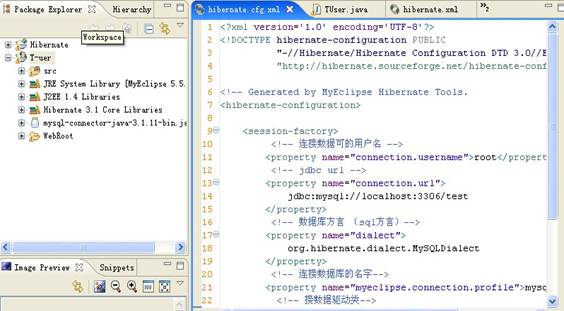Hibernate入門
自己學(xué)軟件編程不久,在學(xué)習(xí)中總結(jié)和記錄啦一些學(xué)習(xí)的入門知識!有不足之處,請批評指正。
Hibernate入門指南
Mike zeseler
Hibernate的5個核心接口:
Session
SessionFactory
Transaction
Query
Configuration
對象“持久化”狹義理解:是把域?qū)ο笥谰帽4娴綌?shù)據(jù)庫中。
持久化和數(shù)據(jù)庫相關(guān)的各項(xiàng)操作:
保存:把域?qū)ο笥谰帽4娴綌?shù)據(jù)庫中
更新:更新數(shù)據(jù)庫中域?qū)ο蟀l(fā)的狀態(tài)。
刪除: 從數(shù)據(jù)庫中刪除一個域?qū)ο蟆?/span>
加載:根據(jù)特定的oid(對象標(biāo)示符)把一個域?qū)ο髲臄?shù)據(jù)庫加載到內(nèi)存中。
查詢:根據(jù)特定的查詢條件,把符合查詢條件的一個或多個域?qū)ο髲臄?shù)據(jù)庫加載到內(nèi)存中。
一:新建項(xiàng)目web java項(xiàng)目都可以
New——》project——》webproject——》T_user
截圖如:

為項(xiàng)目添加hibernateCapabilitise截圖如

點(diǎn)擊next-à如圖:

點(diǎn)擊--ànext如圖:這一步需要詳細(xì)的配置:

一:一般我們需要選擇mysql數(shù)據(jù)庫截圖:

這里的配置需要給大家詳細(xì)的說下:具體情況操作完后慢慢詳細(xì)講解:myeclipse Database Explorer的使用:

Java 前面有個窗口帶+號的標(biāo)示,點(diǎn)擊下就可以出現(xiàn)一個下拉菜單;看看有沒有Database Explorer這項(xiàng),沒有的話點(diǎn)擊other進(jìn)行下一步:
出現(xiàn)一個選框:我們選擇Database Explore這項(xiàng):

點(diǎn)擊ok 完成。
Database Explore的界面截圖:

我們來連接一個數(shù)據(jù)庫。Myeclipse Derby 是myeclipse自帶的一個數(shù)據(jù)庫,它比mysql支持更好的事物(trasaction)。
右擊鼠標(biāo) new一個 newDatabase Connection Driver

這里需要天相關(guān)的配置:
Driver template 選擇你裝好的數(shù)據(jù)庫名稱:我以mysql為例:
Driver name: mysql55 隨你的意思取就ok。
Connection url:jdbc:mysql://<hostname>[<:3306>]/<dbname>
我用的是mysql5則是:jdbc:mysql://localhost:3306/test.
(連接數(shù)據(jù)庫用戶名)username:root
Password: 我的密碼為空();
Driver jars 驅(qū)動類,不同的數(shù)據(jù)庫有不同的jar包,我用的是mysqljar包。
點(diǎn)擊Save password,Connection to database on我們不需要理會,配置好的的截圖:

點(diǎn)擊next—》點(diǎn)擊finish ok完成,以上就是Database Explore。Easy吧。^_^

去掉create SessionFactory class 點(diǎn)擊finish完成。
完成后的截圖
一般的hibernate.cfg.xml配置文件:
|
<?xml version="1.0" encoding="gbk"?><!DOCTYPE hibernate-configuration PUBLIC"-//Hibernate/Hibernate Configuration DTD 3.0//EN" "http://hibernate.sourceforge.net/hibernate-configuration-3.0.dtd"> <hibernate-configuration> <session-factory> <!—顯示實(shí)際操作數(shù)據(jù)庫時的sql(這里是mysql數(shù)據(jù)庫) --> <property name="show_sql">true</property> <!—將顯示的sql排版,方便觀看--> <property name="format_sql">true</property> <!—sql方言,這里設(shè)定的是mysql --> <property name="dialect">org.hibernate.dialect.MySQLDialect</property> <!—JDBC驅(qū)動類--> <property name="connection.driver_class">com.mysql.jdbc.Driver</property> <!-- JDBC URL --> <property name="connection.url">jdbc:mysql://localhost/demo</property> <!—連接數(shù)據(jù)庫用戶名 --> <property name="connection.username">root</property> <!—數(shù)據(jù)庫密碼(我的數(shù)據(jù)庫密碼為空) --> <property name="connection.password"></property> <!—下面的是數(shù)據(jù)庫要映射的文件--> </session-factory> </hibernate-configuration> |
建表:建表語句
|
Create table T_user( id bigint not null auto_increment, name varchar(255), age bigint, primary key(id) )engine=myisam default charset=gbk//支持中文防止插入數(shù)據(jù)出現(xiàn)亂碼 |
Hibernate.cfg.xml實(shí)例
|
<?xml version='1.0' encoding='UTF-8'?> <!DOCTYPE hibernate-configuration PUBLIC "-//Hibernate/Hibernate Configuration DTD 3.0//EN" "http://hibernate.sourceforge.net/hibernate-configuration-3.0.dtd"> <!-- Generated by MyEclipse Hibernate Tools. --> <hibernate-configuration> <session-factory> <!-- 連接數(shù)據(jù)可的用戶名 --> <property name="connection.username">root</property> <!-- jdbc url --> <property name="connection.url"> jdbc:mysql://localhost:3306/test </property> <!-- 數(shù)據(jù)庫方言(sql方言)--> <property name="dialect"> org.hibernate.dialect.MySQLDialect </property> <!-- 連接數(shù)據(jù)庫的名字--> <property name="myeclipse.connection.profile">mysql5</property> <!-- 接數(shù)據(jù)驅(qū)動類--> <property name="connection.driver_class"> com.mysql.jdbc.Driver </property> <!-- 數(shù)據(jù)庫映射文件--> <mapping resource="dao/TUser.hbm.xml" /> </session-factory> </hibernate-configuration> |
首先咋們建立一張表:如上的建表語句:打開database explorer連接數(shù)據(jù)庫,右擊Connected to mysql5,選擇New SQL Editor,寫上建表語句
截圖如下;

點(diǎn)擊綠色的三角符號,建表ok啦!
Ok進(jìn)行下一步:在建好的表上右擊:選擇Hibernate Reverse Engineering,這里需注意我進(jìn)行這步之前首先一定要關(guān)掉如上圖的sql Editor.
Java src folder: 點(diǎn)擊Browser

選擇T_user下的目錄src:點(diǎn)擊ok
進(jìn)行下一項(xiàng):java pakage 我們需填上個dao,名稱無所謂,但是我們要讓別人理解,更容易清楚我們的編程設(shè)計(jì)思想,編程不是讓別人看不懂,自己很牛,但是我們的編碼的最終思想是越來越簡單,不是所謂的越搞越復(fù)雜,讓別人更了解我們的程序。
具體的截圖如下:
點(diǎn)擊下一步

這步其實(shí)沒有什么可以填的,我們直接下一步:

需要注意的是
1:include referenced table(A->B)
2:include referenced table(A<-B)
我們需要勾選他們:
好一切ok啦^_^。咋們點(diǎn)擊finish完成。
生成的目錄

所限我們需要改的是:Tuser.hbm.xml
|
<?xml version="1.0" encoding="utf-8"?> <!DOCTYPE hibernate-mapping PUBLIC "-//Hibernate/Hibernate Mapping DTD 3.0//EN" "http://hibernate.sourceforge.net/hibernate-mapping-3.0.dtd"> <!-- Mapping file autogenerated by MyEclipse Persistence Tools --> <hibernate-mapping> <class name="dao.TUser" table="t_user" catalog="test"> <id name="id" type="java.lang.Long"> <column name="id" /> <generator class="identity" /> </id> <property name="name" type="java.lang.String"> <column name="name" /> </property> <property name="age" type="java.lang.Long"> <column name="age" /> </property> </class> </hibernate-mapping> |
<generator class="identity" />在各項(xiàng)需要改成前面的或是identity。
BaseHibernateDAO
|
package dao; import org.hibernate.Session; /** *Dataaccessobject(DAO)fordomainmodel *@authorMyEclipsePersistenceTools */ publicclass BaseHibernateDAO implements IBaseHibernateDAO {
public Session getSession() { return HibernateSessionFactory.getSession(); }
} |
|
|
IBaseHibernateDAO
|
package dao; import org.hibernate.Session; /** *Dataaccessinterfacefordomainmodel *@authorMyEclipsePersistenceTools */ publicinterface IBaseHibernateDAO { public Session getSession(); } |
HibernateSessionFactory
|
package dao; |
TUser
|
package dao; /** *TUsergeneratedbyMyEclipsePersistenceTools */ publicclass TUser implements java.io.Serializable { // Fields private Long id; private String name; private Long age; // Constructors /**defaultconstructor*/ public TUser() { } /**minimalconstructor*/ public TUser(Long id) { this.id = id; } /**fullconstructor*/ public TUser(Long id, String name, Long age) { this.id = id; this.name = name; this.age = age; } // Property accessors public Long getId() { returnthis.id; } publicvoid setId(Long id) { this.id = id; } public String getName() { returnthis.name; } publicvoid setName(String name) { this.name = name; } public Long getAge() { returnthis.age; } publicvoid setAge(Long age) { this.age = age; } } |
TUserDAO
|
package dao; |
測試代碼:HibernateDemo
|
package onlyfun.caterpillar; import org.hibernate.Session; import org.hibernate.Transaction; import dao.HibernateSessionFactory; import dao.TUser; publicclass HibernateDemo { publicstaticvoid main(String[] args) { TUser tuser = new TUser(); tuser.setName("hibernate測試"); tuser.setAge(new Long(23)); // 開啟Session,相當(dāng)於開啟JDBC的Connection Session session = HibernateSessionFactory.getSessionFactory().openSession(); // Transaction表示一組會話操作 Transaction tx= session.beginTransaction(); // 將物件映射至資料庫表格中儲存 session.save(tuser); tx.commit(); session.close(); System.out.println("新增資料OK!請先用MySQL觀看結(jié)果!"); HibernateSessionFactory.shutdown(); } } |
測試結(jié)果:

測試ok,呵呵。
還有個實(shí)例大家練習(xí)下我這里只給出建表語句:或測試代碼,其他的與上面的方法一樣:
建表語句:
|
Create table Student( Id int not null auto_increment, Uername varchar(200) not null, Password vachar(20) not null, Age int, Primary key (id) )engine = myisam default charset=gbk |
測試代碼:
|
package HibernateTransaction; import java.util.List; import dao.Student; import dao.StudentDAO; publicclass HibernateDAOTest { privatestatic Object results; publicstaticvoid main(String [] args){ //實(shí)例化dao StudentDAO dao = new StudentDAO(); //打開事務(wù) org.hibernate.Transaction tran = dao.getSession().beginTransaction(); //生成普通java類 Student bean = new Student(); //設(shè)置屬性 bean.setUername("struts測試"); bean.setPassword("1234"); bean.setAge(100); //插入數(shù)據(jù) dao.save(bean); //提交事務(wù) tran.commit();
List<Student> results= dao.findAll(); for(Student o : results) { System.out.println("編號:"+o.getId()); System.out.println("姓名:"+o.getId()); } dao.getSession().close(); } } |
posted on 2009-01-15 19:49 mike zeseler 閱讀(4635) 評論(3) 編輯 收藏


